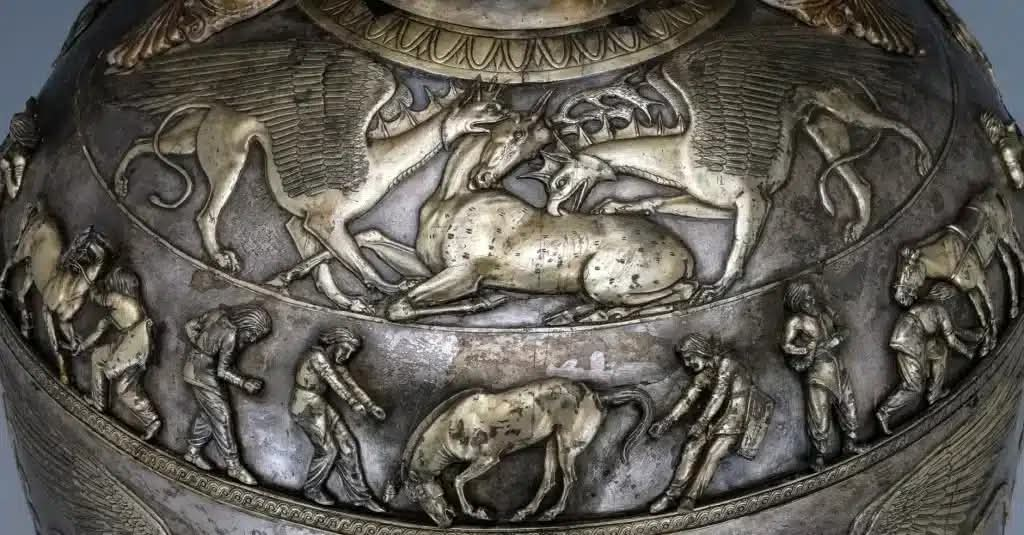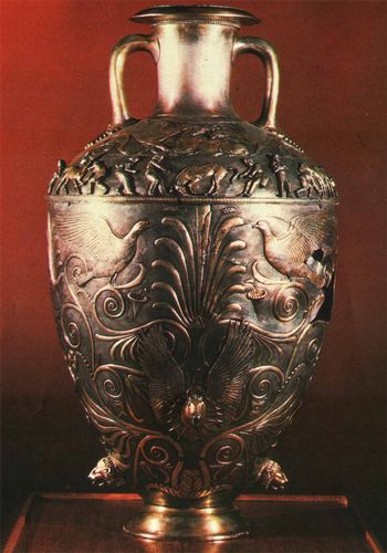The Scythian silver amphora discovered in 1863 at the Chertomlyk Royal Kurgan near Nikopol, Ukraine, stands as one of the most significant artifacts of Scythian culture. This exquisite vessel, approximately 2 feet 4 inches (70 cm) tall, offers profound insights into the artistic mastery and cultural practices of the Scythians, a nomadic warrior society.
Design and Functionality
The amphora’s unique design features a flat base, a departure from the usual pointed base seen in other amphoras, suggesting practical design considerations. The vessel is equipped with a strainer in its neck and three outlets, each fitted with plugs attached by chains. This design likely indicates that the amphora was used for storing liquids, possibly kumys, a fermented milk drink common among the Scythians. The presence of strainers is a notable feature, commonly found in elite Scythian graves, linking the vessel to high-status funerary rituals.

Decorative Artistry and Symbolism
The amphora’s shoulders are decorated with two raised relief bands, each featuring highly detailed scenes. The upper band, gilded and raised, shows griffins attacking a stag, a powerful symbol of Scythian strength. The lower band depicts a scene of breaking in a filly, one of the most iconic motifs in Scythian art, showcasing the Scythians’ profound connection to horses and their equestrian culture.

The figures in the reliefs are separately cast, gilded, and carefully soldered, demonstrating the exceptional craftsmanship of Scythian artisans. The depiction of two different breeds of horses reflects the Scythians’ advanced knowledge of horses, emphasizing their precise and accurate representation of animal life.
Arabesque Decoration: Cultural Reflection
The vase’s surface is adorned with intricate arabesques of palmettes, flowers, and birds, reinforcing the Scythians’ artistic sophistication. These ornamental motifs, along with the detailed relief scenes, reflect a deep appreciation for nature and a highly developed sense of aesthetic and craftsmanship. The gilding and symmetrical patterns further highlight the Scythians’ ability to combine functional and artistic elements in their creations.
![Most famous Scythian silver Amphora/Vase from Chertomlyk Royal Kurgan in Ukraine, 4th c. B.C. [1212 x 1755] : r/ArtefactPorn](https://archeology.dalatcamping.net/wp-content/uploads/2024/12/9lujz45rqivd1.jpg)
Historical Significance: King Aethes’ Burial
The amphora’s discovery in the Chertomlyk Royal Kurgan is strongly linked to the burial of King Aethes (reigned 429–339 BC), a significant Scythian ruler known for his legendary battle against Philip II of Macedon at the age of 90. This battle, in which Aethes was killed, marks an important chapter in Scythian history. The amphora’s ceremonial nature and intricate design suggest the high status of Aethes and the wealth of the Scythian elite.

Conclusion: The Legacy of Scythian Art
The Scythian silver amphora from the Chertomlyk Royal Kurgan is more than just a functional vessel; it is a symbol of the Scythians’ artistic mastery and cultural significance. Through its detailed reliefs, refined craftsmanship, and rich symbolism, the amphora provides a window into the warrior culture, artistic sophistication, and elite funerary practices of the Scythian civilization. This remarkable artifact serves as a lasting reminder of the cultural legacy of a people whose contributions to art and history continue to resonate today.

